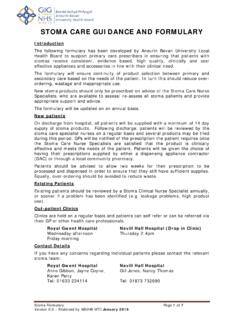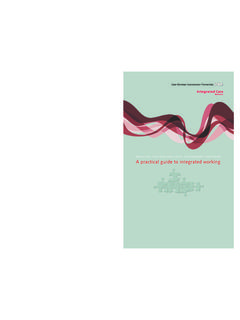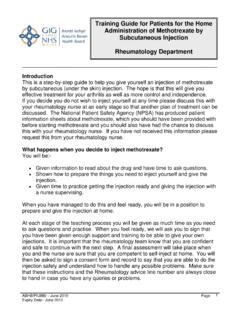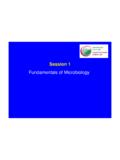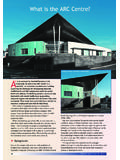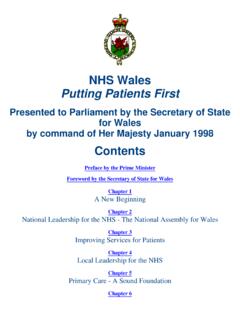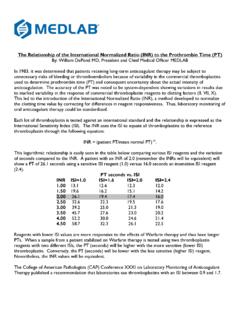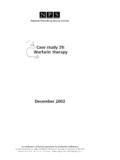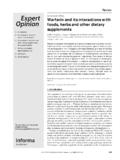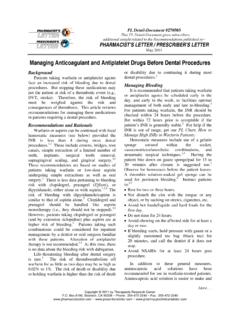Transcription of Anticoagulation in patients with heart valve …
1 Status: Issue 1 Issue date: 27 November 2015 Approved by: Clinical Standards & Policy Group Review by date: 27 November 2018 Owner: Cardiology ABHB/Clinical/0780 Aneurin Bevan University Health Board Anticoagulation in patients with heart valve replacements - Guideline for primary and secondary care. Dr. Christoph M dler, Consultant Cardiologist, ABUHB Dr. Sarah Lewis, Consultant Haematologist, ABUHB Dr. Alun Edwards, General Practitioner, ABUHB Prof. Ulrich von Oppell, Consultant Cardiac Surgeon, C&VUHB Staff should be discouraged from printing this document. This is to avoid the risk of out of date printed versions of the document. The Intranet should be referred to for the current version of the document. Aneurin Bevan University Health Board ABHB/Clinical/0780 Anticoagulation in patients with heart valve replacements Owner: Cardiology Status: Issue 1 Issue date: 27 November 2015 Approved by: Clinical Standards & Policy Group Review by date: 27 November 2018 2 Contents: Introduction 3 Anticoagulation requirements 3 Mechanical (Metallic) prosthetic heart valves 3 Managing Anticoagulation treatment 4 Managing sub-therapeutic Anticoagulation 5 Managing a high INR 6 Managing patients in need of peri-procedure temporary reduction / discontinuation of anti-coagulation 7 Who to ask for advice 8 References 8 Aneurin Bevan University Health Board ABHB/Clinical/0780 Anticoagulation in patients with heart valve replacements Owner: Cardiology Status: Issue 1 Issue date: 27 November 2015 Approved by: Clinical Standards & Policy Group Review by date: 27 November 2018 3 Introduction.
2 All patients with a mechanical heart valve replacement need life-long Anticoagulation with Warfarin. Some patients with bio-prosthetic heart valve replacements (or mitral valve repair) also may need Anticoagulation . The level of Anticoagulation (target INR) is defined by the cardiac surgeon at the time of the operation, and this information needs to be passed on to primary, and secondary care. This document summarises the pathway from tertiary to primary care highlighting respective responsibilities. Routine Anticoagulation is outlined, and guidance for special clinical circumstances, such as under- or over- Anticoagulation as well as peri-procedural management of Anticoagulation is given. A tight collaboration between primary, secondary and tertiary care is of utmost importance to achieve the best possible outcome for our patients with heart valve replacements.
3 Anticoagulation requirements: Biological (Tissue) prosthetic heart valves or valve repair: Aortic position: No warfarin Anticoagulation needed (current recommendation is only for an anti-platelet aggregatory agent, such as Aspirin, for 3 months post surgery), provided patient is in normal sinus rhythm and there is no other indication for Anticoagulation . Mitral and Tricuspid position: Post-operative Anticoagulation with Warfarin is recommended for 3 months only (Target INR ), provided in normal sinus rhythm and there is no other indication for continued Anticoagulation . Mechanical (Metallic) prosthetic heart valves : All patients with mechanical heart valves require life-long Anticoagulation with a Vitamin K antagonist, Warfarin guided by regular monitoring of the international normalised ratio (INR) to inform dosing. New novel oral anticoagulants ( Dabigatran, Rivaroxaban, Apixaban, Edoxaban, etc) are NOT licensed and are clearly CONTRA-INDICATED for use in patients with mechanical prosthetic heart valves .
4 Aneurin Bevan University Health Board ABHB/Clinical/0780 Anticoagulation in patients with heart valve replacements Owner: Cardiology Status: Issue 1 Issue date: 27 November 2015 Approved by: Clinical Standards & Policy Group Review by date: 27 November 2018 4 Managing Anticoagulation Treatment Optimal Anticoagulation in patients with mechanical heart valves is achieved by using a target INR. A median target INR value rather than a range is recommended in order to avoid considering extreme values in the range as being a valid INR, since values at either end of a range are not as safe and effective as median values. (This is different to the current All Wales practice of using an INR range for Warfarin dosing in patients with Atrial Fibrillation or Thromboembolism.) The optimal target INR with mechanical heart valves , depends on the varying thrombotic risk associated with different valve types, and patient-related risk factors: Target INR in mechanical heart valve replacement Mechanical Prosthesis thrombogenicitya Isolated Aortic valve replacement Mitral or Tricuspid valve replacement , or No risk factors b AVR with Risk factors b Low (most current valves ) Medium High aProsthesis thrombogenicity: Low = Carbomedics, Medtronic Hall, St Jude Medical, ON-X; Medium = other bileaflet valves ; High = Lillehei-Kaster, Omniscience, Starr-Edwards, Bjork-Shiley and other tilting disc valves .
5 BPatient-related risk factors: previous thromboembolism; atrial fibrillation; mitral stenosis of any degree, left ventricular ejection fraction < 35%. Ref 1 Note: Patient-related risk factors may change over time and therefore the initial target INR recommended at the time of surgery may change if AF, thromboembolism or severe LV dysfunction subsequently occurs. All patients with mechanical heart valves should undergo a cardiology review at least every 5 years We currently do NOT endorse the company advertised claims that On-X aortic valve can have target INR s lower than that recommended in the above table Aneurin Bevan University Health Board ABHB/Clinical/0780 Anticoagulation in patients with heart valve replacements Owner: Cardiology Status: Issue 1 Issue date: 27 November 2015 Approved by: Clinical Standards & Policy Group Review by date: 27 November 2018 5 The target INR should be defined, and documented, in all cases by the cardiac surgeon performing the valve replacement at the time of the operation.
6 It is mandatory that this information is sent to, and reaches, both the secondary care Cardiologist involved in the patient s follow up and the patient s GP, usually explicitly in the cardiac surgical discharge letter / summary. Prompt documentation of the discharge information in the Cardiff & Vale University Health Board s electronic patient clinical information system (Clinical Portal) will enable robust future reference. Prior to discharge, tertiary care will make arrangements for ongoing INR monitoring and Warfarin dosing, either seamlessly through the GP surgery of the patient, or referral to the INR clinic responsible for overseeing the Anticoagulation from here onwards. This information is recorded on the Warfarin Care Pathway (a copy of which is sent via the patient to their monitoring clinic). If using automated software to measure the INR / inform Warfarin dosing, it is mandatory that this takes into account the patient-specific target INR on each occasion.
7 This should be performed by suitably trained health care professionals, with the ability to override computer generated dosing recommendation if clinically indicated. Managing Sub-therapeutic Anticoagulation (INR falls more than below target INR) [Note: These guidelines are specific to the management of sub-therapeutic Anticoagulation in patients with mechanical valves , and differ from the advice present on the All Wales Warfarin treatment chart.] Point of Care testing machines may have a variance of ~ and therefore in the first instance immediate repeat of INR is recommended with borderline low INR results. Review reason for sub-therapeutic Anticoagulation and increase Warfarin accordingly. These patients will need bridging cover with Heparin. o Intravenous unfractionated heparin (UFH) is the primary recommended treatment for patients with mechanical prosthesis.
8 O However, subcutaneous Low Molecular Weight Heparin (LMWH) at a therapeutic dosage , is accepted as an Aneurin Bevan University Health Board ABHB/Clinical/0780 Anticoagulation in patients with heart valve replacements Owner: Cardiology Status: Issue 1 Issue date: 27 November 2015 Approved by: Clinical Standards & Policy Group Review by date: 27 November 2018 6 alternative for bridging especially in an outpatient setting. o LMWH is relatively contraindicated, as it accumulates, in cases of severe renal failure (eGFR 30 mL/ m2). Contact Haematology for advice in these patients . o The INR needs to be retested in 2 3 days, in order to guide warfarin dosage (after altering warfarin dosage, it takes ~ 48 hrs for the INR to change) until therapeutic. Subcutaneous LMWH - Dalteparin 100 units/kg bd until the INR is within of target INR It is recognised that twice daily dosing may not always be possible.
9 In these patients a once daily regimen according to the patient s weight is suggested Dalteparin: Patient Weight Recommended twice daily dose Dalteparin Once daily dose Dalteparin <46 kg 100 units/kg bd 7500 units od 46-56 kg 100 units/kg bd 10,000 units od 57-68 kg 100 units/kg bd 12,500 units od 69 82 kg 100 units/kg bd 15,000 units od >83 kg 100 units/kg bd 18,000 units od Pre packed syringes are listed in the od regimen it is reasonable to round up in the bd regimens, eg for a patient weight of 60kg, 7500 units in am, 5000 units in pm would be reasonable. Please contact haematology for advice if needed. NB: in some other local Health Boards the LMWH used is Enoxaparin; at a dose of mg/kg daily (target INR or ), or 1mg/kg bd (target INR or ) and not Dalteparin Managing a High INR Life threatening bleeding: Admit to hospital.
10 Omit Warfarin. Intravenous vitamin K 5mg. Aneurin Bevan University Health Board ABHB/Clinical/0780 Anticoagulation in patients with heart valve replacements Owner: Cardiology Status: Issue 1 Issue date: 27 November 2015 Approved by: Clinical Standards & Policy Group Review by date: 27 November 2018 7 Prothrombin complex concentrate, usually 30-50 units/kg, but dose-adjusted according to INR (under the supervision of a haematologist). Minor bleeding from mucosa (nose, oropharynx, urinary tract, rectum, anus) and High INR : INR < but > above target INR o Reduce the warfarin dose (by 10 25%) & recheck INR in 1-2 days (half-life of warfarin is 36 42 hours) INR > 6 o Omit Warfarin for 1 2 days & recheck INR in 1-2 days, reintroducing at a lower maintenance dose when bleeding is under control or when INR < Bleeding whilst in the therapeutic range is usually related to a pathological cause and needs to be identified and treated No bleeding and High INR (INR > 6) Omit Warfarin for 1 2 days & recheck INR in 1-2 days, restart warfarin at a lower dose when INR < Where the perceived risk of bleeding is high, INR >8, or other risk factors for bleeding are present, consider administration of oral vitamin K ( mg).
